
the culture map book pdf
The Culture Map by Erin Meyer is a groundbreaking guide to navigating cultural differences in global business. Available as a PDF, it offers a practical framework for understanding and bridging cultural gaps, essential for international collaboration and leadership success.
Overview of the Book and Its Importance
The Culture Map by Erin Meyer is a vital resource for global business professionals, offering insights into cultural differences across eight key dimensions. Meyer, an INSEAD professor, provides a practical framework for understanding communication, leadership, and decision-making styles worldwide. The book is essential for anyone navigating international collaboration, as it bridges cultural gaps and enhances cross-border effectiveness. Its importance lies in its ability to decode cultural dynamics, enabling leaders to build stronger relationships and make informed decisions. Available as a PDF, the book is accessible globally, making it a must-read for managers and teams working in diverse environments. Meyer’s approach combines real-world examples with actionable strategies.
Why Understanding Cultural Differences Matters in Global Business
Understanding cultural differences is crucial for success in global business, as they profoundly impact communication, trust, and collaboration. Erin Meyer’s The Culture Map highlights how varying cultural norms influence leadership styles, decision-making, and teamwork. Misinterpreting these differences can lead to misunderstandings, conflicts, and failed partnerships. By decoding cultural dynamics, leaders can navigate these challenges effectively, fostering stronger relationships and driving business success. The book’s insights are indispensable for anyone working in a multicultural environment, offering practical strategies to bridge gaps and enhance cross-border collaboration. Its relevance in today’s interconnected world makes it a vital tool for global leaders aiming to thrive in diverse markets.

The Eight Dimensions of Culture in “The Culture Map”
The Culture Map identifies eight key dimensions of cultural differences impacting global business, including communication, evaluation, leadership, decision-making, trust, time, principles, and disagreement.
Communication Styles: High-Context vs. Low-Context Cultures
In The Culture Map, Erin Meyer explores how cultures differ in communication styles, categorizing them as high-context or low-context. High-context cultures, like Japan and Brazil, rely on implicit communication, valuing nonverbal cues and relationships. In contrast, low-context cultures, such as Germany and the U.S., prefer explicit, direct communication. Understanding these differences is crucial for avoiding misunderstandings in global collaboration. Meyer provides practical insights to help leaders adapt their communication strategies, ensuring clarity and effectiveness across cultural boundaries. This dimension is vital for building trust and fostering successful international teamwork, as highlighted in the PDF version of the book.
Evaluation: Direct Negative Feedback vs. Indirect Negative Feedback
In The Culture Map, Erin Meyer examines how cultures approach negative feedback, distinguishing between direct and indirect styles. Direct cultures, such as those in Germany and the U;S., value straightforward, explicit criticism, believing it promotes efficiency and clarity. Indirect cultures, like Japan and India, prefer subtle, nuanced feedback to maintain harmony and avoid embarrassment. Meyer highlights how misaligning these styles can lead to confusion or offense. Understanding these differences is key to fostering trust and improving performance in global teams. The PDF version of the book provides practical strategies to navigate these variations effectively in international collaboration.
Leadership: Hierarchical vs. Egalitarian Societies
In The Culture Map, Erin Meyer explores how leadership styles vary across cultures, distinguishing between hierarchical and egalitarian societies. Hierarchical cultures, such as India and Japan, emphasize respect for authority and clear chains of command, while egalitarian cultures, like Sweden and Australia, favor flatter structures and participative decision-making. Meyer provides insights into how these differences impact global teams, highlighting the importance of adapting leadership approaches to cultural contexts. The PDF version of the book offers practical strategies for leaders to bridge these gaps, ensuring effective communication and collaboration across diverse organizational settings. Understanding these dynamics is crucial for fostering trust and achieving alignment in multicultural environments.
Decision-Making: Consensus-Oriented vs. Top-Down Approaches
In The Culture Map, Erin Meyer examines how decision-making styles differ across cultures, contrasting consensus-oriented and top-down approaches. Consensus-oriented cultures, such as Sweden and Australia, prioritize group agreement and collaborative input, while top-down cultures, like India and Japan, rely on hierarchical decision-making. Meyer provides practical strategies for global leaders to navigate these differences, ensuring alignment and efficiency. The PDF version of the book offers valuable insights into how these approaches impact global teams, helping leaders adapt their decision-making processes to foster trust and achieve results in multicultural environments. Understanding these dynamics is essential for effective cross-cultural collaboration and organizational success.
Trust: Task-Based vs. Relationship-Based Trust
The Culture Map explores how trust is built differently across cultures, distinguishing between task-based and relationship-based trust. Task-based cultures, like the U.S. and Germany, focus on competence and reliability to establish trust. In contrast, relationship-based cultures, such as China and Brazil, prioritize personal connections and shared experiences. Meyer provides practical advice for leaders to navigate these differences, ensuring trust is built effectively in global teams. The PDF version of the book offers insights into how cultural preferences for trust impact collaboration, helping leaders adapt their approaches to foster stronger relationships and achieve business success in diverse environments.
Time Management: Linear vs. Flexible Attitudes Toward Time
The Culture Map examines how cultures perceive time, categorizing them into linear and flexible attitudes. Linear-time cultures, such as Germany and the U.S., value punctuality, schedules, and meeting deadlines. In contrast, flexible-time cultures, like Brazil and India, prioritize relationships and adaptability over strict timelines. Meyer’s framework helps global leaders manage expectations and avoid misunderstandings. The PDF version of her book provides actionable strategies for balancing these differences, ensuring effective collaboration and reducing conflicts in international teams by understanding and respecting diverse time management practices.
Principles: Rule-Oriented vs. Relationship-Oriented Cultures
The Culture Map highlights the tension between rule-oriented and relationship-oriented cultures. In rule-oriented societies, such as Germany and the U.S., adherence to regulations and formal processes is paramount. Decisions are based on logic and established rules. Conversely, relationship-oriented cultures, like China and India, prioritize personal connections and trust over strict rules. Loyalty to relationships often influences decision-making. Meyer’s framework helps global leaders navigate these differences, ensuring ethical and effective collaboration. The PDF version of her book provides insights into balancing these principles, fostering mutual respect and productivity in cross-cultural business environments by understanding these fundamental value systems.
Disagreement: Confrontational vs. Avoidant Approaches to Conflict
The Culture Map explores how cultures handle disagreement, ranging from confrontational to avoidant approaches. In confrontational cultures, like Germany and the U.S., direct conflict is seen as a pathway to clarity and resolution. Open debates and forthright feedback are valued. In contrast, avoidant cultures, such as Japan and Indonesia, prioritize harmony and often avoid direct confrontation to maintain relationships. Meyer’s framework helps leaders understand these differences, fostering effective conflict resolution. The PDF version of her book provides practical strategies for navigating these disparities, ensuring collaboration remains productive and respectful across cultural boundaries. This dimension is crucial for building trust and achieving alignment in global teams.

Practical Applications of The Culture Map
The Culture Map identifies two approaches to conflict: confrontational and avoidant. Confrontational cultures, like Germany and the U.S., embrace direct debate, while avoidant cultures, such as Japan and Indonesia, prioritize harmony over open disagreement. Meyer’s framework provides strategies for leaders to navigate these differences effectively, ensuring collaboration remains productive and respectful. The PDF version of her book offers practical insights for global teams to manage conflicts constructively, fostering alignment and trust across diverse cultural backgrounds. This dimension is vital for successful international collaboration and effective communication in global business.
How to Use the Framework in Global Teams
Erin Meyer’s Culture Map provides a practical toolkit for global teams to navigate cultural differences. By understanding the eight dimensions, leaders can adapt their communication, decision-making, and leadership styles to foster alignment. The framework helps teams anticipate potential misunderstandings and tailor their approaches to diverse cultural contexts. For instance, recognizing whether a culture is high-context or low-context can improve communication clarity. The PDF version of the book includes real-life examples and strategies for applying the framework effectively. Teams can use the Culture Map to create a common language, enhancing collaboration and trust. This approach ensures that global teams leverage cultural diversity as a strength, driving business success worldwide.
Improving Cross-Cultural Communication and Collaboration
Erin Meyer’s Culture Map offers a powerful framework for improving cross-cultural communication and collaboration. By decoding cultural differences across eight dimensions, individuals can better navigate diverse work environments. The book provides practical insights into how communication styles, trust-building, and decision-making vary globally. For example, understanding whether a culture values direct or indirect feedback can significantly enhance teamwork. The PDF version of the book includes real-life examples and actionable strategies for global leaders. Meyer’s approach emphasizes the importance of adapting to cultural contexts while maintaining clear communication. This enables teams to bridge cultural gaps, fostering mutual understanding and effective collaboration in multinational settings. The framework is invaluable for any organization striving to succeed in a globalized world.

Comparing The Culture Map to Other Cross-Cultural Frameworks
The Culture Map stands out among cross-cultural frameworks for its practical, real-world applications. While Hofstede’s theory focuses on broad cultural dimensions, Meyer’s approach offers actionable strategies for global collaboration, making it a preferred tool for modern business leaders seeking to navigate cultural differences effectively.
Similarities and Differences with Hofstede’s Cultural Dimensions Theory
While both The Culture Map and Hofstede’s Cultural Dimensions Theory explore cultural differences, they approach the topic differently. Hofstede’s framework focuses on broad, research-based dimensions like individualism vs. collectivism, while Meyer’s approach is more practical, offering actionable strategies for global collaboration. Both frameworks recognize the importance of understanding cultural nuances but cater to different audiences. Hofstede’s theory is often used in academic and research contexts, whereas Meyer’s Culture Map is tailored for business leaders, providing real-world applications and tools to navigate cross-cultural challenges effectively. Together, they complement each other, offering a comprehensive understanding of cultural dynamics for various purposes.

About the Author: Erin Meyer
Erin Meyer is a renowned professor at INSEAD, specializing in cross-cultural communication. Her expertise helps global leaders navigate cultural differences, making her a trusted voice in international business strategies.
Erin Meyer’s Background and Expertise in Cross-Cultural Communication
Erin Meyer is a distinguished professor at INSEAD, one of the world’s leading business schools. With extensive experience in global business and cross-cultural communication, she has developed a unique framework to decode cultural differences. Her expertise lies in helping leaders and teams navigate the complexities of international collaboration. Meyer’s work focuses on eight key dimensions of culture, providing practical strategies for effective communication and decision-making. Her insights, shared in The Culture Map book and its PDF version, have been widely praised for their relevance and applicability in diverse business environments.

Availability of “The Culture Map” as a PDF
The Culture Map by Erin Meyer is available as a PDF for download on platforms like Scribd and her official website, offering easy access to her insightful framework.
Where to Download or Read the Book Online
Readers can access The Culture Map by Erin Meyer as a PDF through various online platforms. Scribd offers a free download, while her official website provides tools and additional resources. The book is also available for online reading on platforms like Amazon Kindle and Google Books, ensuring accessibility for global leaders seeking to enhance cross-cultural collaboration. These digital versions allow readers to explore the eight cultural dimensions and practical strategies anytime, making it a convenient resource for professionals navigating international business landscapes.
Key Takeaways from “The Culture Map”
The Culture Map provides a practical framework for decoding cultural differences, offering insights into communication, leadership, and collaboration across borders. It equips global leaders with strategies for success.
How to Decode Cultural Differences for Business Success
Decoding cultural differences is crucial for global business success. The Culture Map offers a practical framework to understand and navigate these differences. By analyzing eight key dimensions—such as communication styles, decision-making, and trust—leaders can adapt their strategies to diverse cultural contexts. The book provides real-life examples and actionable insights, enabling professionals to build stronger relationships and improve collaboration across borders. Whether managing global teams or negotiating international deals, this guide equips readers with the tools to decode cultural nuances effectively, ensuring more effective communication and leadership in multicultural environments. Available as a PDF, it’s an essential resource for global business leaders.

Epilogue: Putting The Culture Map to Work
The epilogue emphasizes applying the Culture Map framework in real-world scenarios, providing practical insights for global business success and fostering effective cross-cultural collaboration through actionable strategies.
Implementing the Framework in Real-World Scenarios
Implementing The Culture Map framework involves practical steps to decode cultural differences in global business. As detailed in the PDF, Erin Meyer provides actionable strategies for leaders to navigate communication, leadership, and decision-making across cultures. By understanding the eight dimensions, professionals can adapt their approaches to foster collaboration and avoid misunderstandings. Real-life examples and case studies illustrate how the framework has successfully bridged cultural gaps in multinational teams. The book encourages leaders to tailor their strategies to specific cultural contexts, ensuring effective teamwork and driving business success worldwide. This approach is particularly valuable for global teams aiming to enhance their cross-cultural effectiveness and achieve common goals.

Book Reviews and Feedback
The Culture Map has received widespread acclaim for its practical framework and real-world applications. Experts and readers praise its insights into cross-cultural communication and leadership strategies.
What Experts and Readers Are Saying About The Culture Map
Experts and readers consistently praise The Culture Map for its insightful framework and practical applications; Reviewers highlight Erin Meyer’s ability to break down complex cultural dynamics into actionable strategies, making it an indispensable tool for global leaders. Many have noted how the book’s real-world examples and eight-dimensional model provide clarity and depth, enabling better cross-cultural collaboration. The PDF version has been particularly popular, offering easy access to Meyer’s expertise. Overall, the book is celebrated for its effectiveness in helping professionals navigate the challenges of international business with confidence and sensitivity.

Tools and Resources from The Culture Map
The Culture Map offers a PDF version for easy access and features additional tools on Erin Meyer’s website, including complete culture maps and comparison resources to enhance cross-cultural understanding and collaboration.
Additional Materials Available on Erin Meyer’s Website
Erin Meyer’s website provides additional resources to complement The Culture Map, including PDF guides, tools for comparing cultural dimensions, and interactive maps. These resources help users deepen their understanding of cultural differences and improve global collaboration. Visitors can access detailed culture maps for various countries, enabling comparisons to identify similarities and differences. The website also offers practical strategies for applying the framework in real-world scenarios, making it a valuable hub for professionals seeking to enhance their cross-cultural communication and leadership skills. These materials are designed to support continuous learning and effective implementation of the principles outlined in Meyer’s book.

The Impact of The Culture Map on Global Business
The Culture Map has significantly influenced global collaboration by providing invaluable insights into cultural differences, enabling businesses to enhance cross-cultural communication and leadership, fostering more effective international collaboration.
How the Book Has Influenced International Collaboration
The Culture Map has revolutionized global business practices by offering a clear framework for understanding and navigating cultural differences. Its practical insights have empowered leaders to decode cultural dynamics, fostering more effective communication and collaboration across borders. By categorizing countries along eight behavioral dimensions, the book provides a tool for global teams to anticipate and address potential misunderstandings. This has led to enhanced teamwork, improved decision-making, and stronger relationships in international collaborations. As a result, The Culture Map has become an essential resource for fostering unity and productivity in diverse, global work environments, ensuring sustainable success in today’s interconnected world.
The Future of Cross-Cultural Communication in Business
The Culture Map highlights the growing importance of cultural agility in global business, emphasizing how understanding cultural nuances will shape future collaborations. Meyer’s framework remains a cornerstone for navigating cross-cultural dynamics, ensuring businesses thrive in an increasingly interconnected world. As globalization deepens, the demand for tools like The Culture Map will grow, enabling leaders to bridge cultural gaps effectively and foster successful international partnerships. The book’s insights will continue to guide businesses in adapting to diverse cultural landscapes, ensuring long-term success in global markets.
Emerging Trends and The Role of The Culture Map
As global business evolves, cultural agility is becoming a critical skill for leaders. The Culture Map by Erin Meyer provides a timeless framework for navigating cross-cultural dynamics, addressing emerging trends like remote work and digital communication. With increasing diversity in global teams, understanding cultural differences is more essential than ever. Meyer’s insights help leaders anticipate and manage cultural clashes, fostering collaboration and innovation. The book’s practical strategies are particularly relevant in today’s interconnected world, where businesses must adapt to diverse markets and workforce demographics. By leveraging The Culture Map, organizations can build stronger international relationships and thrive in an increasingly complex global landscape.